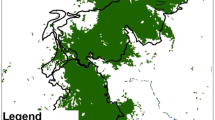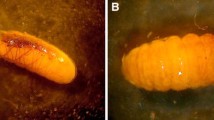Abstract
Rhopalomastix is a myrmicine ant distributed throughout tropical parts of Asia, with almost nothing known about its biology. Its closest relative Melissotarsus in Africa is the only ant genus known to live with diaspidid scale insects inside their nests, and to rely on these for food. Twelve colonies of four species of Rhopalomastix were sampled from seven tree genera in Singapore. Ants chewed tunnels under live bark, and these were occupied by many diaspidids belonging to five genera; at least two species are known to also live freely on the outside of trees. Inside ant nests, only a few diaspidids secreted their trademark shields. The association with the pupillarial Fiorinia is unexpected, since they have fewer secretions that can be used as food by the ants. Rhopalomastix and Melissotarsus workers share several morphological adaptations, including powerful mandibles and silk glands, but while the legs of Melissotarsus are modified for traction during tunnelling, those of Rhopalomastix are not. Consequently, Rhopalomastix workers are able to walk outside their tunnels, but they behaved timidly except in R. murphyi. Silk was used to repair damaged tunnels, and the spinning behaviour resembled that of Melissotarsus. Host trees do not gain protection from the ants against leaf herbivores, so they apparently get no benefits from this mutualism. We discuss the likely economic impact of this parasitic lifestyle, especially on fruit trees.






Similar content being viewed by others
References
Aicher S, Stapf G (2016) Compressive strength parallel to the fiber of spruce with high moisture content. Eur J Wood Wood Prod 74:527–542
Akter S, Islam MT, Zulkefeli M, Khan SI (2013) Agarwood production—a multidisciplinary field to be explored in Bangladesh. Int J pharm life sci 2:22–32
Bequaert J (1922) Ants in their diverse relations to the plant world. Bull Am Mus Nat Hist 45:333–583
Ben-Dov Y (2010) On new taxa and some described armoured scale insects (Hemiptera: Diaspididae) living in the galleries of the ant Melissotarsus insularis Santschi (Hymenoptera: Formicidae) in Madagascar. Zootaxa 2368:49–58
Ben-Dov Y, Fisher BL (2010) The mutualism of Melissotarsus ants and armoured scale insects in Africa and Madagascar: distribution, host plants and biology. Entomol Hellenica 19:45–53
Blaimer BB, Ward PS, Schultz TR, Fisher BL, Brady SG (2018) Paleotropical diversification dominates the evolution of the hyperdiverse ant Tribe Crematogastrini (Hymenoptera: Formicidae). Insect Syst Div 2:3. https://doi.org/10.1093/isd/ixy013
Blüthgen N, Mezger D, Linsenmair KE (2006) Ant-hemipteran trophobioses in a Bornean rainforest–diversity, specificity and monopolisation. Insect Soc 53:194–203. https://doi.org/10.1007/s00040-005-0858-1
Bolton B (1982) Afrotropical species of the myrmicine ant genera Cardiocondyla, Leptothorax, Melissotarsus, Messor and Cataulacus (Formicidae). Bull Brit Mus (Nat Hist) Entomol 46:307–370
Buckley R, Gullan P (1991) More aggressive ant species (Hymenoptera: Formicidae) provide better protection for soft scales and mealybugs (Homoptera: Coccidae, Pseudococcidae). Biotropica 23:282–286
Das SC (1976) Survey of scale insects in Darjeeling. Two Bud 23:12–19
Dill M, Williams DJ, Maschwitz U (2002) Herdsmen ants and their mealybugs partners. Abh Senckenberg Naturforsch Gesellsch Frankfurt 557:1–373
Eguchi K, Bui TV, Yamane S (2011) Generic synopsis of the formicidae of vietnam. Part 1—Myrmicinae and Pseudomyrmecinae. Zootaxa 2878:1–61
Fisher BL, Robertson HG (1999) Silk production by adult workers of the ant Melissotarsus emeryi (Hymenoptera, Formicidae) in South African fynbos. Insect Soc 46:78–83. https://doi.org/10.1007/s000400050116
Floren A, Linsenmair KE (1999) Changes in arboreal arthropod communities along a disturbance gradient. Selbyana 20:284–289
Foldi I (1990) The scale cover. In: Rosen D (ed) Armored Scale Insects: their biology, natural enemies and control [vol 4A]. Elsevier, Amsterdam, pp 43–54
García MM, Denno BD, Miller DR, Miller GL, Ben-Dov Y, Hardy NB (2018) ScaleNet: a literature-based model of scale insect biology and systematics database. Available at http://scalenet.info. Accessed 19 Nov 2018
Gullan PJ, Buckley RC, Ward PS (1993) Ant-tended scale insects (Hemiptera: Coccidae: Myzolecanium) within lowland rain forest trees in Papua New Guinea. J Tropical Ecol 9:81–91. https://doi.org/10.1017/S0266467400006994
Handler AT, Gruner DS, Haines WP, Lange MW, Kaneshiro KY (2007) Arthropod surveys on Palmyra Atoll, Line Islands, and insights into the decline of the native tree Pisonia grandis (Nyctaginaceae). Pacific Sci 61:485–502
Heckroth HP, Fiala B, Maschwitz U (1999) Integration of scale insects (Hemiptera: Coccidae) in the South-east Asian Ant-Plant (Crematogaster (Formicidae)-Macaranga (Euphorbiaceae)) system. Entomologica 33:287–295
Hölldobler B, Obermayer M, Plowes NJR, Fisher BL (2014) New exocrine glands in ants: the hypostomal gland and basitarsal gland in the genus Melissotarsus (Hymenoptera: Formicidae). Naturwiss 101:527–532. https://doi.org/10.1007/s00114-014-1186-y
Huxley CR, Cutler DF (eds) (1991) Ant-Plant interactions. Oxford University Press, Oxford
Khalife A, Keller R, Billen J, Hita Garcia F, Economo E, Peeters C (2018) Skeletomuscular adaptations of head and legs of Melissotarsus ants for tunnelling through living wood. Front Zool 15:30. https://doi.org/10.1186/s12983-018-0277-6
Koteja J (1990) Life History. In: Rosen D (ed) Armored Scale Insects: Their Biology, Natural Enemies and Control [vol 4A]. Elsevier, Amsterdam, pp 243–254
Liu Y, Chen H, Yang Y, Zhang Z, Wei J, Meng H, Gao Z (2013) Whole-tree agarwood-inducing technique: an efficient novel technique for producing high-quality agarwood in cultivated Aquilaria sinensis trees. Molecules 18:3086–3106
Loi A, Luciano P, Gilioli G, Bodini A (2012) Lasius brunneus (Formicidae Formicinae) and Stomaphis quercus (Aphidoidea Aphididae): trophobionts harmful to cork oak forests in Sardinia (Italy). Redia 95:21–29
Maschwitz U, Hänel H (1985) The migrating herdsman Dolichoderus (Diabolus) cuspidatus: an ant with a novel mode of life. Behav Ecol Sociobiol 17:171–184. https://doi.org/10.1007/BF00299249
Matile-Ferrero D, Foldi I (2018) A new genus of armoured scale insects living without scales inside nests of the ant Rhopalomastix johorensis in Singapore (Hemiptera, Coccomorpha, Diaspididae). Bull Soc Entomol France 123(4):525–528. https://doi.org/10.32475/bsef_2058
Miller DR, Davidson JA (2005) Armored scale insect pests of trees and shrubs (Hemiptera: Diaspididae). Cornell University Press, Cornell
Mony R, Kenne M, Orivel J, Dejean A (2002) Biology and ecology of pest ants of the genus Melissotarsus (Formicidae: Myrmicinae), with special reference to tropical fruit tree attacks. Sociobiol 40:645–654
Oldfield S, Lusty C, MacKinven A (1998) The World List of Threatened Trees. World Conservation Press, Cambridge
Peeters C, Foldi I, Matile-Ferrero D, Fisher BL (2017) A mutualism without honeydew: what benefits for Melissotarsus emeryi ants and armoured scale insects (Diaspididae)? PeerJ 5:e3599. https://doi.org/10.7717/peerj.3599
Peeters C, Ito F, Wiwatwitaya D, Keller R, Hashim R, Molet M (2017) Striking polymorphism among infertile helpers in the arboreal ant Gesomyrmex. Asian Myrmecology 9:e009015. https://doi.org/10.20362/am.009015
Retuerto R, Fernández-Lema B, Obeso JR (2004) Increased photosynthetic performance in holly trees infested by scale insects. Funct Ecol 18:664–669
Schneider SA, Okusu A, Normark BB (2018) Molecular phylogenetics of Aspidiotini armored scale insects (Hemiptera: Diaspididae) reveals rampant paraphyly, curious species radiations, and multiple origins of association with Melissotarsus ants (Hymenoptera: Formicidae). Mol Phylogenet Evol 129:291–303. https://doi.org/10.1016/j.ympev.2018.09.003
Styrsky JD, Eubanks MD (2007) Ecological consequences of interactions between ants and honeydew-producing insects. Proc R Soc Lond B 274:151–164. https://doi.org/10.1098/rspb.2006.3701
Takagi S, Kondo D (1997) Further forms for the Rugaspidiotini-problem II: a new scale insect associated with mango-tree in India (Homoptera: Coccoidea: Diaspididae). Insecta Matsumurana 53:93–99
Ueda S, Quek SP, Itioka T, Inamori K, Sato Y, Murase K, Itino T (2008) An ancient tripartite symbiosis of plants, ants and scale insects. Proc R Soc Lond B 275:2319–2326. https://doi.org/10.1098/rspb.2008.0573
Wang WY, Yong GWJ, Jaitrong W (2018) The ant genus Rhopalomastix (Hymenoptera: Formicidae: Myrmicinae) in Southeast Asia, with descriptions of four new species from Singapore based on morphology and DNA barcoding. Zootaxa 4532:301–340
Wei J, Zhang B, Feng J (2013) Two new species of Fiorinia Targioni-Tozzetti (Hemiptera: Coccoidea: Diaspididae) from China. Zootaxa 3641:92–100
Wheeler WM (1929) The ant genus Rhopalomastix. Psyche 36:95–101
Acknowledgements
We are grateful to Weeyawat Jaitrong, Wendy Wang and Seiki Yamane for discussions about Rhopalomastix taxonomy. We thank Chui Shao Xiong for field photos of colonies. Adam Khalife and Roberto Keller kindly helped with the images of mounted diaspidids. Thibaud Monnin provided constructive comments. Field trips to Singapore (CP) were funded by Wildlife Reserves Singapore Conservation Fund (WRSCF). We acknowledge the National Parks Board (permit no. NP/RP15-011-2c, NP/RP16-121) for permission to conduct field surveys in Singapore.
Author information
Authors and Affiliations
Corresponding author
Electronic supplementary material
Below is the link to the electronic supplementary material.

40_2019_686_MOESM1_ESM.jpg
Mounted adult female of Andaspis numerata from a colony of R. murphyi, showing tentorium (Tent), stylets (Styl), pygidium (Pyg) and an embryo (Emb) (JPG 1669 KB)

40_2019_686_MOESM2_ESM.jpg
Surface of bark with tunnels outlined by wood shavings (frass) in colony K. Photograph by Chui Shao Xiong (JPG 14936 KB)

40_2019_686_MOESM3_ESM.jpg
Tunnels at different levels in the bark of Durio zibethinus (colony A) showing thickness, spatial arrangement and constant diameters of tunnels chewed by Rhopalomastix. Scattered diaspidids are visible. Bark surface is at the bottom (JPG 10242 KB)

40_2019_686_MOESM4_ESM.jpg
Damaged shield of Pseudaulacaspis samoana showing eggs and crawlers (with antennae; red arrow) inside colony I2 (Rhopalomastix johorensis). Note an apparent inclusion (exuvia?, black arrow) in the shield (JPG 18267 KB)

40_2019_686_MOESM5_ESM.jpg
Naked second instars with ventral layer of wax (green circles) in Rhopalaspis peetersi. First instar exuviae are missing in some, revealing they have been removed (eaten?) by the ants (JPG 10440 KB)
Stereotyped behaviour of ‘head-bobbing’ in Rhopalomastix murphyi (colony C). Silk is applied along the edges between exposed and intact tunnels (AVI 15859 KB)
Rights and permissions
About this article
Cite this article
Yong, G., Matile-Ferrero, D. & Peeters, C. Rhopalomastix is only the second ant genus known to live with armoured scale insects (Diaspididae). Insect. Soc. 66, 273–282 (2019). https://doi.org/10.1007/s00040-019-00686-z
Received:
Revised:
Accepted:
Published:
Issue Date:
DOI: https://doi.org/10.1007/s00040-019-00686-z




